Cosmology
The Big Bang Universe, 95 % unobservable in hypothetical dark matter and dark energy is giving way to one alive with electric plasma currents accumulating mass and transferring energy over galactic and intergalactic space in a cosmic extravaganza of constant creation Dr. Mae-Wan Ho
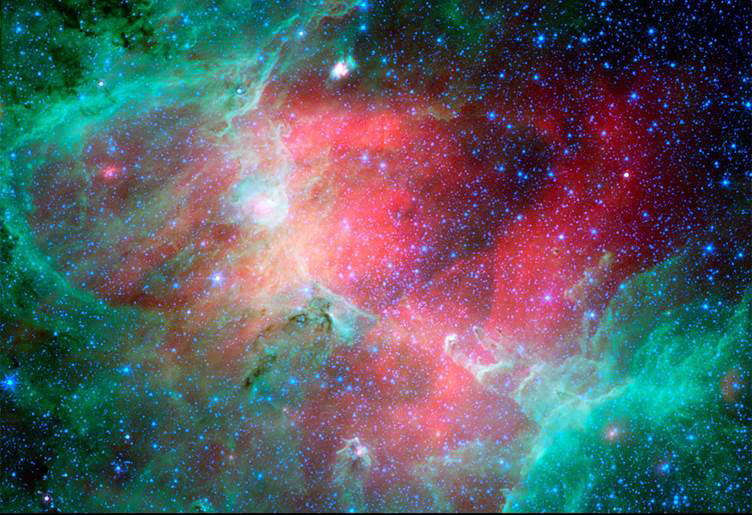
Stars and galaxies, NASA image
Imagine the moment our human ancestors first lifted their eyes to gaze deep into night sky; that must have been the very moment art/myth/religion/science was conceived, and cosmology – the quest for the origin and development of our universe – has held our fascination and imagination undiminished ever since.
Some would argue that the currently dominant Big Bang science theory of the universe has strong elements of mythology if not artistic verisimilitude (see [1] Galaxy Making Stars at the Edge of the Universe & Other Anomalies, SiS 60), and it is being defended by an establishment with a zeal bordering on blind faith and religious fervour. So much so that 34 eminent scientists from 10 countries around the world were moved to sign an open letter criticising the establishment, calling for openness and funding to investigate the validity of Big Bang and its alternatives, among them, Steady State and Plasma cosmology (Box 1).
Box 1
Open Letter from eminent scientists criticising the Big Bang establishment
An “Open Letter to the Scientific Community” was published in 2004 in the New Scientist magazine, signed by 34 eminent scientists from 10 countries around the world [2]:
“The big bang today relies on a growing number of hypothetical entities, things that we have never observed-- inflation, dark matter and dark energy are the most prominent examples. Without them, there would be a fatal contradiction between the observations made by astronomers and the predictions of the big bang theory.
“What is more, the big bang theory can boast of no quantitative predictions that have subsequently been validated by observation. The successes claimed by the theory's supporters consist of its ability to retrospectively fit observations with a steadily increasing array of adjustable parameters, just as the old Earth-centred cosmology of Ptolemy needed layer upon layer of epicycles…
“Even observations are now interpreted through this biased filter, judged right or wrong depending on whether or not they support the big bang. So discordant data on red shifts, lithium and helium abundances, and galaxy distribution, among other topics, are ignored or ridiculed. This reflects a growing dogmatic mindset that is alien to the spirit of free scientific enquiry…”
The letter ended with a call for funding to investigate the validity of Big Bang and its alternatives, among them, Steady State and Plasma cosmology, both proposing an evolving universe without beginning or end, the latter able to explain the basic phenomena of the cosmos without invoking dark energy and dark matter.
Big Bang cosmology was developed on features of the universe that could be seen with telescopes through light emitted in the visible part of the electromagnetic spectrum, a narrow band less than one octave with wavelengths between 390 and 700nm. Since the 1970s, space research has extended the acquisition of data over almost the entire electromagnetic spectrum spanning 73 octaves from g-rays, x-rays and ultraviolet at the very high energy end to infrared, microwave and radio waves at the other. This opened up a vast panorama that we could only peek at previously through a slit in a black cosmic curtain. Before our far- and wide-reaching telescopic eyes (Figure 1), an extravaganza in the entire electromagnetic spectrum is unfolding in universal space-time. X-ray bursts, the most energetic events, change their output by orders of magnitude in seconds or milliseconds, some 1010 times faster than those in the visual range [4].
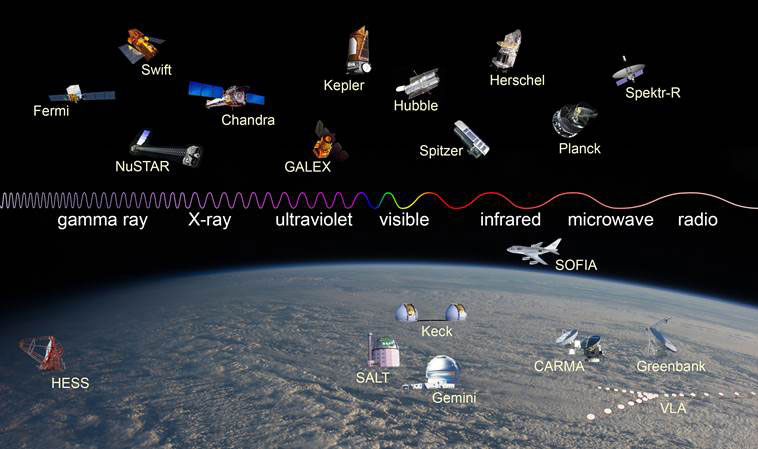
Figure 1 sample of telescopes (operating as of February 2013) at wavelengths across the electromagnetic spectrum (NASA)
These observations posed immediate problems for Big Bang cosmology. ‘Parameters’ were added to create the Lambda-Cold Dark Matter (LCDM) cosmology, also known as the Standard Model (of the universe) [5]: the “simplest model that provides a good match” (retrospectively) to observations including the cosmic microwave background and the accelerating expansion of the universe observed in the light from distance galaxies and supernovae.
The expansion of the universe is inferred from the amount of redshift in the light coming from astronomical objects (see [1]). Redshift happens when light from an object moving away from the observer is increased in wavelength or shifted to the lower energy end of the electromagnetic spectrum. American astronomer Edwin Hubble (1889-1953) discovered that the redshift of a galaxy increases with its distance from the earth, implying that the universe is expanding. A linear relationship between redshift and distance holds below a redshift of 0.1. For distant galaxies and supernovae, however, the light emitted is too faint, implying that they are more distant than expected, and hence can only be explained by an “accelerated expansion” [6].
Lambda (L) stands for the cosmological constant, the value of the energy density of vacuum space, also known as dark energy, a hypothetical entity needed to explain the accelerating expansion of space against the attractive (collapsing) effects of gravity due to matter. Currently about 68.3 % of the energy density in the universe is estimated to be dark energy.
‘Cold dark matter’ is a form of hypothetical matter needed to account for gravitational effects observed in very large scale structures, such as the rotation of galaxies, and enhanced clustering of galaxies that cannot be accounted for by the quantity of observed matter (see [1]). Cold dark matter consists of matter other than protons and neutrons in ordinary matter; it does not dissipate or collide, and interacts with other particles or matter purely through gravity. Dark matter currently accounts for an estimated 26.8 % of the mass-energy density of the universe. This leaves 4.9 % ordinary matter.
By definition, dark matter and dark energy cannot be detected; and are no more than hypothetical parameters invented to save Big Bang cosmology. Additional problems arise in equating redshift with recession and distance from Earth.
Astronomer Halton Arp was Edwin Hubble’s assistant early in his career; and worked at the Mt. Palomar and Mt Wilson observatories for years, where he developed his famous catalogue of “Peculiar Galaxies”. Arp discovered that many pairs of quasars (quasi-stellar objects) that have extremely high redshift z values and therefore thought to be receding from Earth very rapidly and extremely distant from us are physically connected to galaxies that have low redshift and known to be relatively close by. Arp has many pairs of high redshift quasars symmetrically located on either side of what he suggests are their parent low redshift galaxies [7] (see [1]). Arp believes that the observed redshift value of any astronomical object is made of two components: the inherent component (due to the plasma) and the velocity component. But the velocity component is the only one recognized by mainstream astrophysicists (which leads to all kinds of paradox concerning distances, age of the universe, and its accelerated expansion). Arp believes that high redshift is a sign of youthfulness rather than age, and further showed that the inherent redshift values of quasars appeared to be quantized, ie, exists in definite jumps.
The mainstream ignored Arp’s observations, and tried to explain them away as “illusions” or “coincidences of apparent location”. Arp was (and still is) systematically refused telescope time and denied publication of his findings, which appeared in his book Seeing Red: Redshifts, Cosmology and Academic Science [8]. Arp was not alone among the silenced critics of Big Bang cosmology (see Box 1).
Recently, Ari Brynjolfsson has proposed a theory on intrinsic redshift based on the interaction of one photon with a collective of many electrons in the plasma [9-11], and that too, has fallen on deaf ears.
The new Plasma cosmology is based largely on electromagnetic forces - up to 39 orders of magnitude stronger than gravity - and has no need for dark matter or dark energy.
Plasma is a conglomerate of charged particles that respond collectively to electromagnetic forces [4]. It is considered a fourth state of matter distinct from solid, liquid, and gas. Plasmas can be created and studied in the laboratory, and their properties can be scaled up over many orders of magnitude.
Swedish plasma physicist Hannes Alfvén (1908-1995), awarded the Nobel Prize in physics for his work on the dynamic behaviour of electrically conducting fluids including plasmas, was a pioneer proponent of the Electric Plasma Universe [4]. He was the first to point out that X-rays and γ-rays detected by the special telescopes orbiting in space are produced by magnetized plasmas. Magnetized plasmas, especially in connection with double layers (of positive and negative charges) and magnetic field aligned electric field (see later) accelerate electrons streaming from the sun to some 103 eV (electron volts) to create the auroras at the poles. Solar flares produce electrons with energies 109 to 1010 eV. Under cosmic conditions, even higher energies are possible. High energy magnetized plasmas not only emit X-rays and g-rays, but also synchrotron radiation (continuous band of polarized radiation emitted by charged particles spinning in a magnetic field) that often falls in the radio bands. Hence, radio astronomy also gives information about the plasma universe.
The Universe is 99.999% plasma. It is alive with electric plasma currents accreting and concentrating mass and transferring energy over galactic and intergalactic distances, organizing space into cells surrounded by sheets and filaments of plasma bounded by electric double layers. The circuit paths are closed, sometimes over very large distances. Plasmas in relative motion in one part of the universe can produce prodigious amounts of electrical energy, and the energy transferred over many billions of light years to suddenly burst from a very small and localized region.
Both in the laboratory and in the solar system, filamentous and cellular morphology is well-known for plasma (Figure 2). In the 1980s, unexpected filamentous structures turned up on the galactic, intergalactic and supergalactic scales.
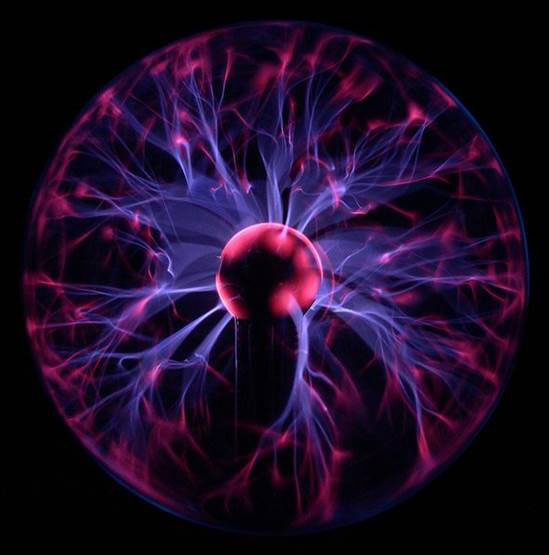
Figure 2 Small plasma lamp with central cathode surrounded by an excited spherical current sheet attracted to the outer glass shell (anode); filamentous structures form as the current sheet propagates through the low pressure medium within the lamp (Lu Viatour, www.lucnix.be)
Along the boundaries between cells, filaments and sheets of plasma organize into Birkeland currents (see Box 2), named after Norwegian researcher Kristian Birkeland (1867-1917), who deduced that the flow of electrons from the sun was the source of the Northern lights at the beginning of the 20th century [13]. Magnetic field aligned electric (Birkeland) currents were discovered in Earth’s magnetosphere in 1974; and auroras are now attributed to the filamentation of charged plasma sheets following Earth’s magnetic field lines into vortex current bundles. Birkeland currents exist also on the galactic and supergalactic scales, and are very effective at aggregating matter.
Box 2
Birkeland current and accretion of matter
A Birkeland current is an electric current aligned with a magnetic field [13]. Any current flowing in a conductor or filament will induce a magnetic field B around it. The lines of equal magnetic flux density will be in the form of rings around the current axis, with magnetic flux density decreasing away from the axis. The interaction of the current with its own magnetic field will cause a pressure to develop radially inward on the current filament according to the vector product of current I and magnetic field B written as (I x B). This is referred to as a Z-pinch. In a metal conductor, the pressure is resisted by the atomic ion lattice. In a plasma current, the pressure can be balanced by the pressure of the plasma inside the filament. This results in a steady state where the current can flow axially across its circling magnetic field. The pinch effect can be demonstrated in the laboratory to crush aluminium cans by applying a strong magnetic field very quickly. Magnetic field forces in lightning can create an inward pinch strong enough to crush a solid copper grounding rod.
In space, the neutral gas pressure is usually negligible. The only way the situation can be resolved is for the I x B force to disappear. That happens when current direction and magnetic field direction are parallel, so the vector product is zero. The result is a field-aligned current.
To get to that state, electrons near the centre of the filament flow in almost straight lines and generate the ring shaped magnetic field around them. This influences the electrons further from the centre causing them to move in a more helical path (like a solenoid) aligned with the main current direction. This helical motion creates in turn the straight magnetic field lines close to the axis. Any individual electron in the current is flowing along the magnetic field direction in its own vicinity, but collectively the filament is preserved. This means very large currents can be assembled out of small current elements and transmitted over huge distances.
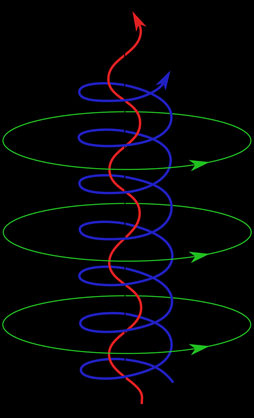
Figure 3 A Birkeland current with self-constricting magnetic field lines and current paths that may develop in plasma [14] (see text)
In summary, the absence of significant pressure in space plasmas create force-free currents flowing in cylindrical filaments aligned with the general magnetic field direction. Within the cylindrical filament, both the current and the magnetic field will spiral around the axis of the cylinder. The force-free or field aligned arrangement is a minimum energy state for the current to flow in, hence it is inherently stable.
But suppose that the current I in the Birkeland current is caused by an electric field E. There is also a force arising from the interaction of E and the magnetic field B. E will not be entirely aligned with the total B, which is the vector sum of the external magnetic field through which the current flows and the magnetic field generated by the current itself. The E x B force occurs wherever E is not parallel to B. This E x B force acts on charged particles in and around the current cylinder and causes both ions and electrons to move toward the centre of a filament. Plasmas often contain a high proportion of charged dust grains, which will also be drawn into the filament. Viscous drag between the charged particles and neutral atoms will tend to draw the neutral atoms toward the filament as well. Thus, current filaments in space will tend to accumulate matter as a result of the misalignment of the electric field causing the current and the total magnetic field.
As pinches can occur if there is any misalignment of I and B, matter drawn into the filament will also be compressed. If the pinch force is large enough, it can fragment the filament into discrete spherical or toroid plasmoids along the axis of the current. Any matter in the pinch zone would become compressed into the same form.
Birkeland currents interact to form systems of galaxies [15, 16], according to Anthony Peratt, plasma physicist at Los Alamos National Laboratory New Mexico in the United States, and a leading proponent of the Electric/Plasma Universe. Birkeland currents in astrophysical plasmas with dimensions ranging from 102 to nearly 1021 m are thought to carry currents of 105 to 1019 A (amperes). The entire filamentous circuit is expected to be hundreds of megaparsec long with complex patterns of fields and currents. (A parsec is an astronomical unit equal to 3.26 light-years or 3.08567758 x 1016 m, so a Mpc (megaparsec) is 3.26 million light years.)
Galaxies form along the filaments, and this explains the chains of galaxies that seem to be linked like pearls on a string. Large masses of galaxies also formed along the original plasma cell boundaries, accounting for the “Great Walls” and the grand sheets of galaxies that have been observed.
Notably, a three-dimensional ‘map of the universe’ constructed on super-computers by the Virgo consortium (Figure 4) shows filaments stringing galaxies and walls of galaxies surrounding cells precisely in the manner predicted by the pioneers of the Electric Plasma cosmologist more than 35 years ago [4, 17]. But the map of the model universe is attributed to the special distribution of dark matter and dark energy [18].
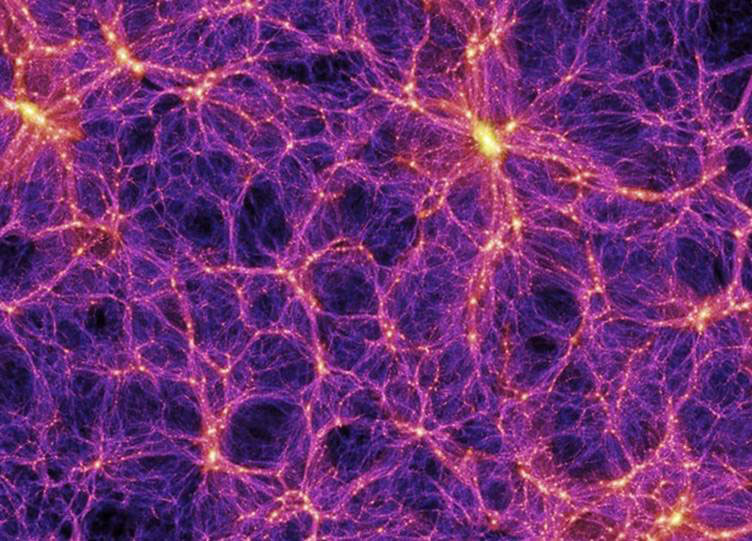
Figure 4 Map of the Universe, Max Planck Institute of Astrophysics [18]
Electromagnetic/electromechanical forces are enormously stronger than gravity, they can collect and compress matter much more efficiently than gravitational forces (Box 2) and account for the map of the universe without invoking dark matter or dark energy. Once matter is sufficiently compressed and neutralized by recombination of ions and electrons, then electromagnetic forces may be reduced to the point that gravity becomes significant and continues the compression.
Birkeland currents not only explain the formation of galaxies, they could also account for the non-random distribution of elements in the cosmos through a process of electrical sorting known as Marklund convection (Box 3).
Box 3
Marklund convection
In a cylindrical current, the E x B force is radially inwards and results in the self-constriction of a current filament and an increase in the particle density near the axis of the current (see Box 2). Two things can happen: radiative cooling from the regions of increased density near the centre, and recombination of ions and electrons starts [13].
Every chemical element has a particular energy level known as its ionization energy at which it will either ionize or recombine. A characteristic velocity - the Critical Ionization Velocity (CIV) - can be derived at which the kinetic energy of motion is equal to the ionization energy. The CIV values of elements commonly found in space are not randomly distributed but are grouped into four distinct bands.
In the vicinity of a field-aligned current, the E x B force causes a l drift of ions and electrons from the periphery toward the cooler central axis. On account of their differing CIVs, different ions will recombine at different radii as they move towards the centre to progressively cooler regions (Figure 5). This process is known as Marklund convection after the Swedish physicist Göran Marklund who discovered it.
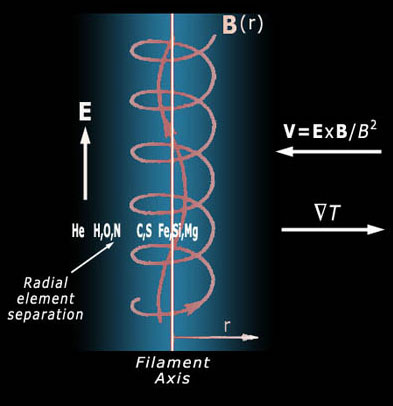
Figure 5 Marklund convection and electrical sorting in a magnetically pinched current (image courtesy of Wal Thornhill, www.holoscience.com)
The net result is that Marklund convection sorts elements into different bands according to their ionization potentials, the groups of elements are arranged in cylindrical shells at different radii within a cylindrical field-aligned current. As hydrogen has a high CIV compared to the other elements, it will recombine first. This type of electrical sorting may be responsible for some of the non-random distribution of elements observed in the cosmos. In particular, it may explain the preponderance of neutral hydrogen in thread-like structures throughout the galaxy that have been detected by radio telescopes, as for example, the x-ray emitting arms of Coma cluster (see [1]).
Perratt developed a model of how galaxies form by studying the interaction between galactic-dimension Birkeland currents and using supercomputers to simulate a local fraction of the complete circuit that interacts with a local region in a neighbouring filament.
Parallel axial currents within the filaments are long-range attractive while circular helical currents within the filaments are short-range repulsive [13]. If the axial currents are able to bring the filaments close enough together so that the repulsive component of the Lorentz force (force exerted by magnetic field on moving electric charges) become important the circular currents repulse and brake, and release energy in the form of synchrotron radiation. This is the beginning of galaxy formation as first described in detail in two papers published in 1986 [15, 16].
The plasma simulations were able to replicate the evolution sequence from double radio galaxies and quasars to peculiar and elliptical galaxies and spiral galaxies starting from pairs of interacting Birkeland current filaments (Figures 6, 7) as well as other galactic features such as jets (19).
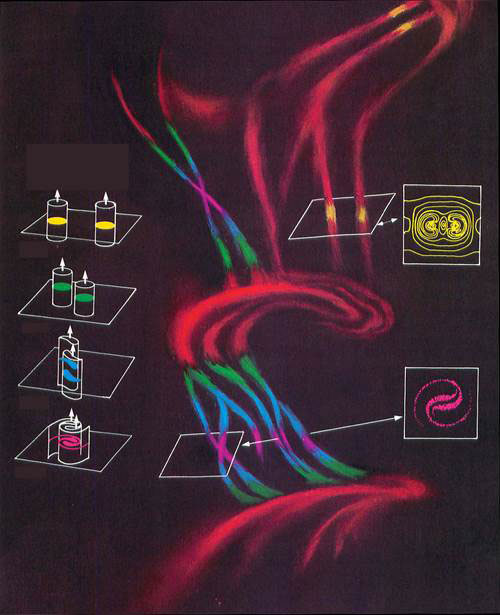
Figure 6 In the Plasma Universe swirling streams of electrons and protons form Birkeland filaments; the particles gain velocity indicated by the colours and at narrow pinch regions produce the full range of galaxy types as well as the full spectrum of cosmic electromagnetic radiation (modified from [19])
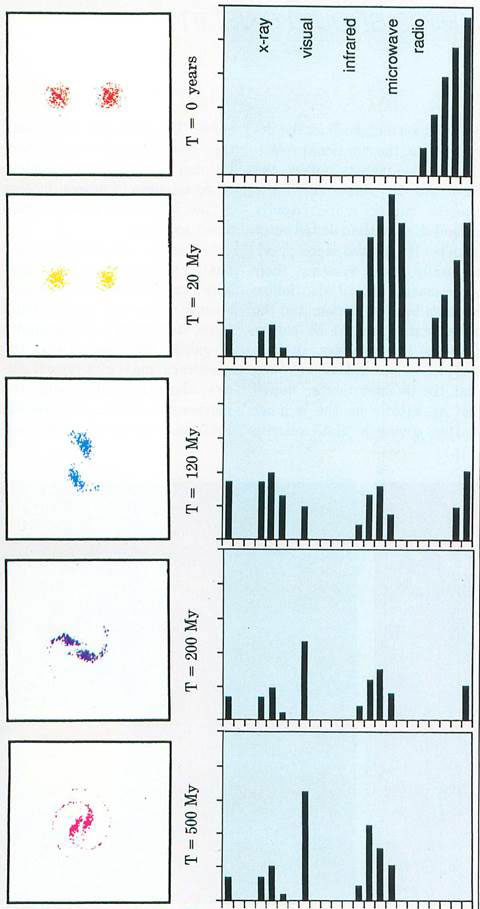
Figure 7 Simulation of evolving galaxies (time in millions of year); plasma distribution left, radiation spectrum right (modified from [19])
As explained succinctly and clearly by Stephen Smith [20]:
“The two Birkeland filaments (also concentrating matter within their magnetically pinched volume) torque around each other, changing the morphology of the core plasma (flattening the ellipse) and eventually evolving into trailing arms as electric current, axial to the arms, flows into the core of the galaxy. At that point the two Birkeland filaments merge with the core. So the core of a galaxy derives from whatever intergalactic plasma was trapped between the two (or more) Birkeland filaments and the arms of the spiral derive mostly from the pinched Birkeland filaments themselves.
“The rotating Birkeland filaments impart the initial rotational momentum to the galaxy-sized plasma structure. As the charged plasma structure rotates, there arises a concomitant magnetic field with a typical “dynamo” signature.
“Current continues to run through the galaxy along the equatorial plane as part of a larger intergalactic circuit. This current as it passes through the magnetic field mentioned above drives further rotational energy as the galaxy responds as a homopolar motor. This is what drives the “anomalous” rotational velocities observed in the outer parts of galaxies.
“Further magnetic fields arise in the galaxy as a result of the intergalactic currents running in along the equatorial plane. The currents running radially along the equatorial plane create local magnetic fields that squeeze the plasma into Birkeland filaments. This brings definition to the spiral arms. Further filamentation and higher current densities power star formation in the spiral arms.”
Perratt’s proposal for how galaxies form also applies to how cluster of galaxies form; and give birth to quasars (proto-galaxies) as envisaged by Arp. The Birkeland currents involved are simply bigger.
Unexpectedly, Perratt discovered from his simulations a background of microwaves with an energy density very nearly the same as the cosmic microwave background (CMB), which has been deemed the single most important confirmation of Big Bang cosmology. In the laboratory, a filamentous plasma or electron beam that does not produce microwaves is unknown, which is why it has been necessary to absorb the microwaves for safety reasons.
The distribution of radiation energy of the Plasma Universe was not calculated until 6 years after the simulations began. The result was “startlingly close” to the CMB. In an infinite universe of plasma filaments, the microwave background from synchrotron sources would necessarily be very smooth, without the need for a big bang.
Bob Johnson of the Thunderbolt Project reviewed this article and provided helpful comments.
Article first published 11/11/13
Comments are now closed for this article
There are 10 comments on this article.
Ken Conrad Comment left 12th November 2013 06:06:40
I believe it was Fred Hoyle who coined the term “Big Bang” in his critic of the expanding universe model.
As an alternative to the Big Bang theory, Hoyle, Bondi and Gold proposed the "steady state" theory, stating that the universe simply always existed.
Hoyle began his scientific career as a determined atheist and philosophical materialist; in other words, he believed that there is nothing more than what meets the eyes. Over the course of time however he pronounced himself "greatly shaken", and by the time of his death, Hoyle believed that life had to have been the result of some unseen intelligence and that, "there is a coherent plan for the universe, although I admit I have no idea what it is”.
In commenting on lecture given by Fred Hoyle Halton Arp states in an article he wrote on his website,
“During the years I visited with Fred from time to time to show him the newest observational results which were struggling to get published. He would instantly size up the results and say something like, Well chip, they will certainly have to admit now that their assumptions are wrong. After a while we both knew that it would not be accepted in the foreseeable future. He never dwelt on the lost effort, money or the dismal state of the science. He was always trying to think ahead to the next insight, the next synthesis of physics. It will always be a pleasure and inspiration however to look back and read his clear, courageous logic and also sad to think how far ahead we might be now if more people had joined in the discovery of new understandings instead of insisting on complexifying and patching up their commitment to old dogma. I can still hear him saying, They defend the old theories by complicating things to the point of incomprehensibility.
We should have crossed over that bridge to a more correct physics that Fred pointed to so clearly more than three decades ago.”
jocelyn Braddell Comment left 12th November 2013 08:08:39
How thrilling to read this article. I am an old woman of eighty years and have since young always looked at the sciences with intense interest - and I always detested the Big Bang theory. We had, here in Ireland for a few years a unique individual who had theories that he was hoping to follow up. James P.Hogan. An American-Irish writer of Science Fiction boos. He came here and bought a farm in Meath especially to study plasma electronics re. the universe. I am sure he is nown to you as he lectured and wrote about his theories that he said he had obtained by "flexible thinking" that he recomended for everyone!! He was interested in the Russian author Velikovsy, one of whose books Albert Einstein was reading when he died. Sadly that adventurous thinker died undertaking too much heavy work on his farm. His entire interest was to overcome these Big Bang merchants and he wrote some papers on plasma etc.
Again, in these utterly depressing series of years it is like a very extra treat for you to send me this paper that I scan without exactly understanding but with the gratitude of an early student. Jocelyn Braddell
Mae-Wan Ho Comment left 12th November 2013 08:08:20
Thank you Ken for the interesting history on Fred Hoyle, and Jocelyn for your information regarding James Hogan. No, I confess to being entirely ignorant of his activities. Please forward my piece to him and see what he thinks. I would love to hear from him.
maewan
jocelyn braddell Comment left 12th November 2013 18:06:06
Sorry I did not make it clear about James Hogan. He bought a farm and was intent on farming as a longed-for life experience - however he undertook the drainage of some fields, he was alone at the time as his wife was visiting her relatives, and he had a heart attack. Evidently without help he could not live. I read this on the internet. There is a pdf of a lecture he gave that included his enthusiasm about the electro-magnetic substance of the universe. He abhorred the Big Bang but could not among scientific acquaintances get anyone in America to listen to him! That is why he came here hoping the enthusiasm that exists in the sciences in Ireland would be compatible for his achievements. Very sad. Thank you for replying. You are someone I very much admire, and many of your article were reproduced in the internet magazine I edited - The Handstand. Now no longer existing except as a flag in the winds of the internet. www.thehandstand.org Sincerely Jocelyn
Todd Millions Comment left 17th November 2013 19:07:54
I've read of Kepler toying with magnetic and or static electrical feilds to form a rope the moon and planets could swing around-thus an unknown force(gravity) would not have too be invented or invoked.He got the half the distance,twice the force point very well apparently.But he lacked the time too pursue these notions- the casting horoscopes,couldnt wait as he needed the money to bail his mom out of jail on witchcraft charges(apparently she was and a good one).
May hap if Newton hadn't screwed around wasting time on the number of the beast or size of noahs ark-he would have had time too invent the calculus,and used it to confirm his trigometry derived moon orbit model.Droll if kepler was also right.
Natalie Nagel Comment left 19th November 2013 20:08:17
Maewan, I have learned immensely from you since I first heard your keynote lecture at the 2013 EU Conference and had lunch with you and Greg Volk at Whole Foods later during that week. Your Rainbow Worm and coherent domain data and explanations opened up biophysics for me. Thank you! Greg Volk (president, NPA) is now working to complete the principle showing that the corkscrew, always rotating quickly, results in a net gain in energy (free energy is the term used by those who have not yet read Greg's mathematical analysis). The corkscrew is the basis for Birkeland Currents, as Stephen Smith shows, the most stable, long-lasting form in the universe. My work, published in my first NPA paper 'PLASMA to plasma: Universal Fractal Flow' and presented at the 2013 NPA Conference, shows that DNA, the most long-lasting biological form, mirrors the Birkeland current. Your research is referred to from the first paragraph of my short paper. Greg and I talk on a bi-weekly basis and I am now showing further how living systems mirror the plasma properties you refer to here in your 'Continuous Creation' paper. I am working to show that the 'Birkeland current form' in DNA, that is, the double helix flow of electrons, is in what I call 'plasma water' (because of the separation of charge) hugging the DNA. Gerry Pollack would call this EZ water. I have found an independent research paper showing that, unsurprisingly, dehydration results in mistakes in DNA replication. When you and I spoke at the 2013 EU conference, you asked me to email you. I have waited until now because at this point in my research I have questions which I think you, uniquely, will be able to answer.
Hysen berisha Comment left 18th September 2014 04:04:14
I'm so glad that I stumbled up on this article. It gives life such a deeper meaning than the theory's that scientists have now a days. I am baffled at the theory of simulated universe which has gained rather some attention in the pas decade. The electric universe theory has a more deep and powerful meaning than a quantatized and granular one. Thank you so much for your article.
Rogers Follansbee Comment left 17th January 2015 05:05:36
What baffles me is that there are still accredited scientists out there that continue to believe it possible that the universe could have had a beginning. The only way that the universe (existence itself) could have had a beginning is by having that beginning commence from a state of non-existence yet to propose that from such a state existence could emerge would be in blatant violation of the law of non-contradiction; a law which is simply impossible to violate. Real science is based upon the constant application of this law whether it's practitioners recognizes it or not. You would think that we were still in the dark ages when we listen to the likes of Krauss and many others who practice mainstream and quantum physics. How it is possible that learned people still resist applying the very laws they unconsciously live by also in their daily work is beyond me.
Rory Short Comment left 6th August 2015 02:02:19
I am a software engineer not a physicist or a mathematician so am unable to follow the maths but none the less the electric universe theory has more intuitive appeal for me than the inert and lifeless Big Bang theory.
PANAGIOTIS STEFANIDES Comment left 16th April 2016 01:01:53
Very interesting ideas.
Attach my work, of possible interest:
http://www.stefanides.gr/Html/GOLDEN_ROOT_SYMMETRIES.html
http://www.stefanides.gr/pdf/BOOK%20_GRSOGF.pdf
Regards from Athens,
Panagiotis Stefanides
http://www.stefanides.gr